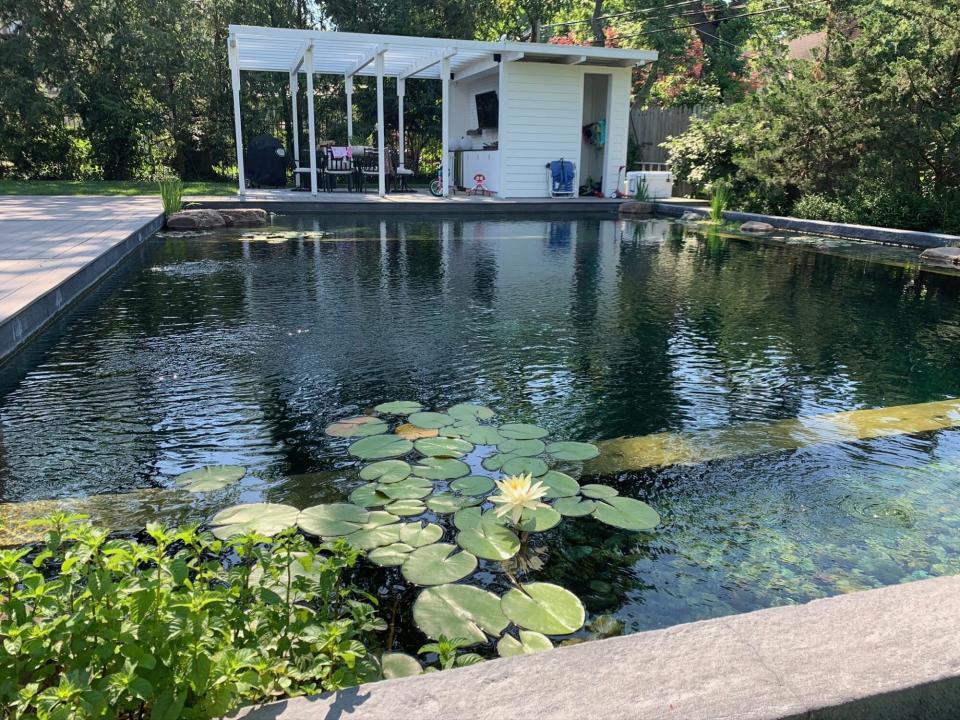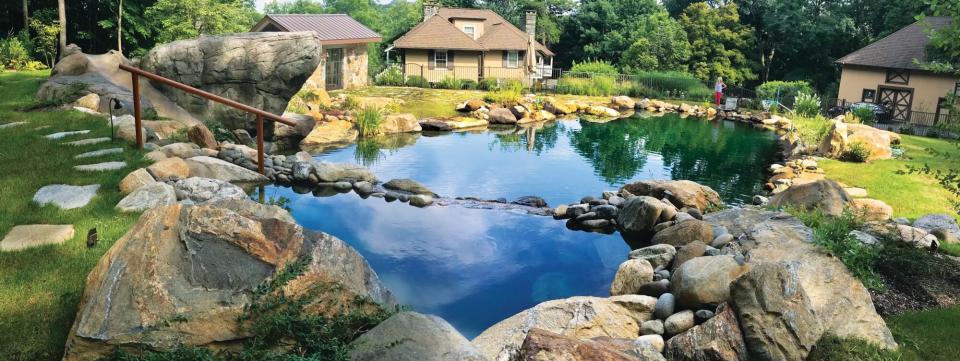Natural Swimming Pools Are the Charming, Chemical-Free Alternative to Chlorine Pools
Looking for a chemical-free alternative to a traditional pool? Or a backyard swim spot that fits into the surrounding environment? For eco-conscious homeowners who want a place to swim without the environmental impact, a natural swimming pool might be the answer.
Also called a natural pool, swimming pond, or a living pool, natural swimming pools have been established in Europe for decades, and they continue to gain awareness in the U.S. as their style and eco-forward function is embraced by more pool designers, builders, and homeowners.

Courtesy of Total Habitat
What Is a Natural Swimming Pool?
Unlike traditional pools, which rely on chemicals like chlorine, a natural swimming pool uses continuously moving fresh water and natural filters to keep the pool perfect for swimming. "Natural pools combine all the benefits of a pool and a decorative pond," says Sophia Elniff, designer at Total Habitat, a company specializing in natural swimming pools. These pools incorporate plant life, bacteria, and other natural materials to create a self-contained pool—in many ways a human-made wetland ecosystem—that not only filters water and fights algae, but also fits more harmoniously into the environment.
Natural swimming pools are essentially composed of two key parts: a swimming area and a water filtration area. "All natural pools have built-in plumbing systems—what varies is exactly how and where the water is naturally filtered," Elniff says. "Sometimes the filtration happens in a separate filter pond, sometimes it is around the outside edges of the pool in a planted filter area," she says.
The term "regeneration zone" is often used to refer to the separate filter ponds that use aquatic plants to filter the water and manage microbes so it stays clean for swimming. Natural swimming pool also incorporate plant life, but instead, the main filtration relies on bacteria inside the built-in biological filters. This approach hides filtration, often behind rock walls or in the floor of the pool.
Related: Budget-Friendly Pool Deck Ideas
Other variations include how (and how often) the water is moved through the filter area, as well as the size of the filter area. For example, a waterfall might be used to move water between the regeneration zone and the swimming area. Typically, natural swimming pools relying on planted filters require more area than a design based on a hidden filtration system. Although they can be built like a traditional pool (with a concrete and plaster base), they are often formed with materials like boulders, gravel, water plants, and a pond liner for a more organic appearance.

Courtesy of Total Habitat
How Big Is a Natural Swimming Pool?
Natural swimming pools are likely to be bigger than a traditional swimming pool, though that's not always the case. One reason is because of the regeneration zone required for many types of natural swimming pools. Generally speaking, the larger the pool, the larger the regeneration zone. The plant life portion can be equal to or larger than the actual swimming area in order to best naturally filter and treat the water. BioNova, another U.S. natural swimming pool company, says a 16x32 foot swimming zone would require an equal 512-square-foot regeneration zone.
Natural swimming pools that rely on built-in plumbing systems and filters, like the ones designed by Total Habitat, can be smaller. "We can build a natural pool in just about any shape or size imaginable, from a small dip pool of just 8 or 10 feet overall to a swimming pond the size of an acre or two," Elniff says. "I've even designed a stock tank natural pool."
Related: How to Make a DIY Stock Tank Pool
Another reason natural swimming pools can be larger than a standard chlorine pool is that their design often includes more features than a traditional pool. Waterfalls, streams, jumping boulders, piers, in-water seating, waterslides, infinity edges, and beach-like gradual entries are possible special features. "The design of a natural pool also often includes other poolside elements like a pergola, deck, patio, or hot springs," Elniff adds.

Courtesy of Total Habitat
How Much Does a Natural Swimming Pool Cost?
The cost of a natural swimming pool varies greatly depending on the size and design, including water-filtering plants, perimeter landscaping, and water features. Is it a swimming pool with a secondary planted filter pool? That will impact building material and construction costs, as you're basically building two pools. Pools that rely on built-in filter systems might be more comparable in price. BioNova's website says a biofilm filter pool costs $60,000-$75,000 for a typical 16x32 foot pool. Total Habitat has example installations on their website ranging from $75,000 to more than $175,000.
Although initial costs are often more expensive than traditional pools, you'll often save in long-term maintenance because natural swimming pools don't require routine chemical treatments. Many natural swimming pools can also stay filled year-round (depending on the type of pool and geographic location), eliminating seasonal emptying, winterizing, and refilling costs.

Courtesy of Total Habitat
Pros of Natural Swimming Pools
The best part of natural swimming pools is that they are better for the environment. Since they don't rely on chlorine, salt, or chemicals for upkeep, the pool and its surrounding area are a safer place for both people, pets, and plants. The lack of chemicals also makes them less onerous and costly to maintain.
But just because they don't need the frequent testing and chemical balancing doesn't mean they are maintenance-free. Like traditional swimming pools, natural swimming pools need periodic skimming and debris removal, and their filters and pumps need cleaning. Plant life providing filtration will need nurturing and natural bacteria might need to be added to the biological filter systems to keep the water fresh.
Another major benefit of natural swimming pools is their style. "When you are not actively using the pool for swimming, you can enjoy views of it and the nature it brings to your space," Elniff says. Designs that are important to a pool's function also create stunning features; regeneration plants add to the landscaping while supporting your backyard's ecosystem, too.
Natural swimming pools are also more flexible than a traditional pool. If you prefer the look of a standard pool yet want the environmental benefits, their ability to be installed without a major regeneration zone means it's possible to have both.

Cons of Natural Swimming Pools
Natural swimming pools have higher up-front costs and often require more space than most standard backyard pools. In addition, natural swimming pools are less common than chlorinated pools, which makes it harder to find professionals familiar with their specific design and construction. Not every local pool company can design and install a natural swimming pool. Obtaining a building permit is also a potentially less straightforward process. Pool permits always vary by project and location, but Elniff notes that permitting offices might categorize these projects as ponds rather than pools.
Selecting and installing a natural swimming pool can also be a longer, more involved process, too. It's not quite as turnkey as picking out a prefab pool. Designers have to visit the property and become familiar with the space and land for both design ideas and critical function assessments. "We size our bio-filters based on total gallons of a given pool plus site-specific factors like climate, wind exposure, and sun time per day," Elniff says. "From start to finish, the design process typically takes 2-4 weeks depending on how busy we are."
Elniff also notes that construction times vary based on the design, location, and availability of materials. Again, since some styles require building two pools, it's logical it might take more time. Time is also needed for water plants and bacteria to take hold.

